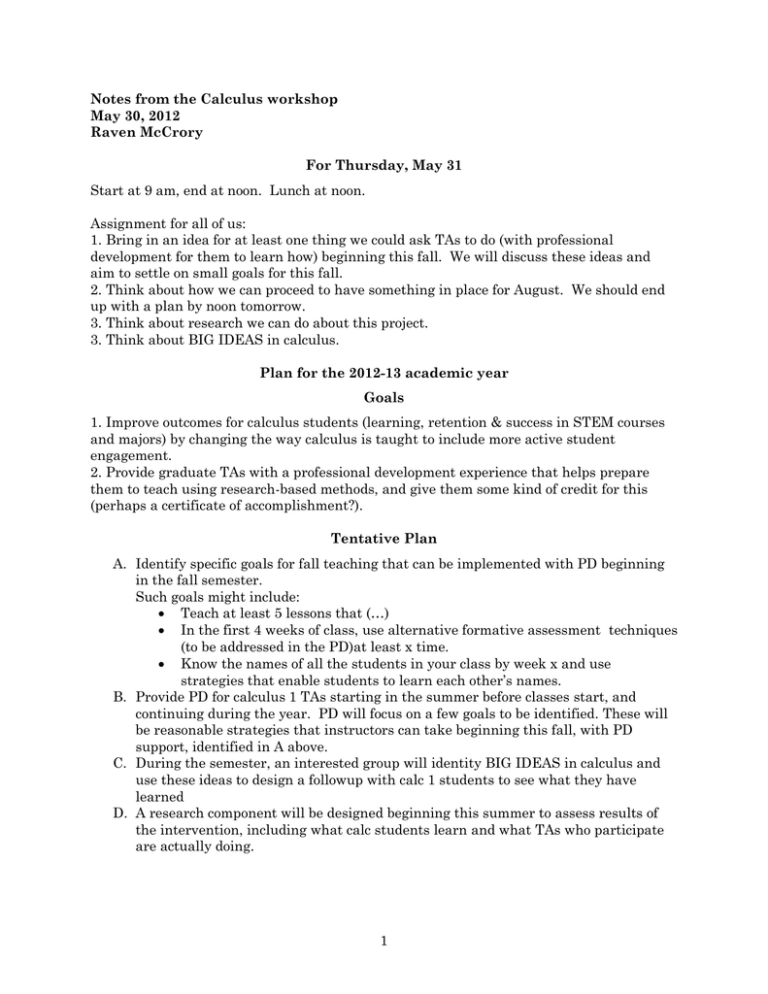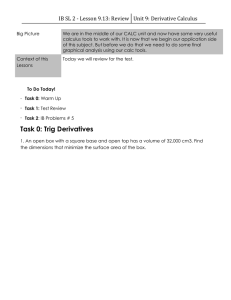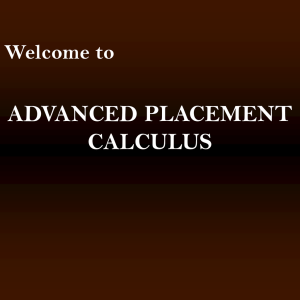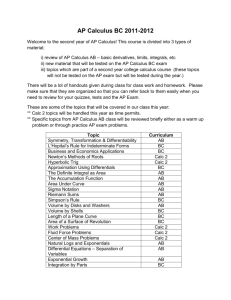Other discussions - CREATE for STEM Institute at MSU
advertisement

Notes from the Calculus workshop May 30, 2012 Raven McCrory For Thursday, May 31 Start at 9 am, end at noon. Lunch at noon. Assignment for all of us: 1. Bring in an idea for at least one thing we could ask TAs to do (with professional development for them to learn how) beginning this fall. We will discuss these ideas and aim to settle on small goals for this fall. 2. Think about how we can proceed to have something in place for August. We should end up with a plan by noon tomorrow. 3. Think about research we can do about this project. 3. Think about BIG IDEAS in calculus. Plan for the 2012-13 academic year Goals 1. Improve outcomes for calculus students (learning, retention & success in STEM courses and majors) by changing the way calculus is taught to include more active student engagement. 2. Provide graduate TAs with a professional development experience that helps prepare them to teach using research-based methods, and give them some kind of credit for this (perhaps a certificate of accomplishment?). Tentative Plan A. Identify specific goals for fall teaching that can be implemented with PD beginning in the fall semester. Such goals might include: Teach at least 5 lessons that (…) In the first 4 weeks of class, use alternative formative assessment techniques (to be addressed in the PD)at least x time. Know the names of all the students in your class by week x and use strategies that enable students to learn each other’s names. B. Provide PD for calculus 1 TAs starting in the summer before classes start, and continuing during the year. PD will focus on a few goals to be identified. These will be reasonable strategies that instructors can take beginning this fall, with PD support, identified in A above. C. During the semester, an interested group will identity BIG IDEAS in calculus and use these ideas to design a followup with calc 1 students to see what they have learned D. A research component will be designed beginning this summer to assess results of the intervention, including what calc students learn and what TAs who participate are actually doing. 1 Other discussions Ideas Use the LESSON STUDY model for the TA professional development Development a certification process for TAs who learn to teach through active student engagement. (Make MSU a place where math PhDs are known for being outstanding teachers.) TAs could limit lecture to 20 minutes and use the rest of the class for problem solving, sharing results Calculus classes could be “flipped” using external resources for lectures and using class period for collaborative work, discussion. Calc student could be asked to write a short reflection on their own learning each week – a 5 minute fast write. TAs could provide pre-class (conceptual) questions that studenst answer and submit before class for a check on understanding. Change the curriculum to focus more on modeling and other things needed by engineers. Improve pre-calc courses so students come in with stronger preparation. “If the U wants these 1825 and 103 students to succeed, we need to do something different.” What kinds of incentives could help faculty adopt new ways of teaching? Use projects Segregate sections of precalc (calc?) by type of student – recitations for engineering students, e.g. Other possible goals Change the content or organization of the courses (e.g., the “Macalester model”) Change the number of credits given for calc 1, from 3 to 4 Add recitation sections to later calc courses Start a larger discussion about first year content in mathematics and elsewhere for STEM students. Make MSU a place where math PhDs are known for being outstanding teachers. Issues Students get credit for calculus courses that they take all over Michigan. Changing the number of credit hours is a lengthy and sometimes contentious process. Maybe some other course – e.g., number theory – would be more suitable as an opening course instead of Calc 1. Resources 1. Epstein, The Calculus Concept Inventory, http://www.openwatermedia.com/downloads/STEM(for-posting).pdf#page=64 2. Carlson, M., Oehrtman, M., & Engelke, N. (2010). The precalculus concept assessment: A tool for assessing students' reasoning abilities and understandings. Cognition and Instruction, 28(2), 113-145. doi: 10.1080/07370001003676587 2 3. MAA, CBMS versions of what calculus should include (Brin Keller is going to give us more info about this) 4. “The good questions project” at Cornell University. http://www.math.cornell.edu/~GoodQuestions/ 5. Gavin Larose project page, University of Michigan. http://www.math.lsa.umich.edu/~glarose/courseinfo/calc/calcprojects.html 6. Lesson Study at the University level: Karon Marongelle, Oregon; Jennifer Kaplan, Texas; 4. Curriculum Foundations Project, available for download at www.maa.org/cupm/crafty/cf_project.html 5. Beyond Crossroads: Implementing Mathematics Standards in the first two years of college (2006). AMATYC http://beyondcrossroads.amatyc.org/doc/PDFs/BCAll.pdf Other resources: PI video from Mazur: http://youtu.be/wont2v_LZ1E Also, Mazur’s PI manual: http://mazur.harvard.edu/education/pi_manual.php 3




